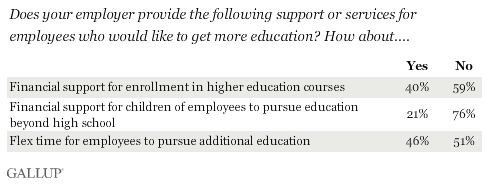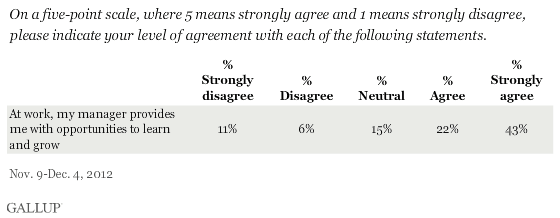WASHINGTON, D.C. -- Among a list of various ways to make higher education more affordable, Americans are most likely to want institutions of higher education to reduce their tuition and fees, followed by having companies provide more assistance to their employees. Fewer Americans strongly back more assistance from federal and state governments or from community-based organizations.

These findings are from a Nov. 9-Dec. 4, 2012, study by Gallup and the Lumina Foundation with a random sample of 1,009 U.S. adults. The same survey found that Americans have a strong demand for education beyond high school and say that having a post-secondary degree or credential is very important to getting a good job and to improving earning potential.
Americans Say Employers Are Short on Support for Educational Attainment
In contrast to Americans' desires for employers to provide more tuition support, the majority of U.S. workers report that their employers do not offer critical support and services to help them pursue more education. Three in four workers say their employer does not provide financial support to the children of employees to pursue education beyond high school. Another 59% say their company does not provide financial support to their employees for enrollment in higher education courses.
The relative bright spot is that nearly half of all American workers say their employer does allow its employees to exercise flextime to pursue more education, although a full 51% says this is not an option.

Mixed Review of Learning and Development Opportunities
Forty-four percent of workers say their company provides on-site training that leads to a workplace certificate, while 54% report their employer does not. However, significantly fewer, 36%, say their company offers any other type of educational support.

Through research, Gallup has learned that on-the-job learning opportunities are one key factor of workplace engagement and performance.
Thus, it is important to note that when Gallup asks if workers agree or disagree with the statement that their manager at work provides them with opportunities to learn and grow, 65% generally agree. Using a five-point scale, where 5 means they strongly agree and 1 means they strongly disagree, 43% strongly agree and 22% agree. About one-third (32%) disagree or are neutral on the question.

Bottom Line
Americans are convinced of the importance of acquiring post-secondary education or learning. While the majority of Americans generally support increased government assistance to help students pay for college, more respondents believe lowering tuition costs and having employers step in to help their employees obtain advanced learning are the best approaches to addressing the high costs.
Read the report: America's Call For Higher Education Redesign.
Survey Methods
This report presents findings from a quantitative survey that Gallup conducted on behalf of Lumina Foundation. The overall objective of the study was to determine the perceptions of the general American population about several important issues pertaining to higher education, including degree attainment, quality and value, costs, and innovative learning models. The study measures public attitudes about higher education generally, as well as other topics, namely, barriers to degree attainment and responsibility for financing higher education. To achieve these objectives, Gallup conducted 1,009 interviews with individuals 18 years and older residing in landline-telephone households, cellphone-only households, and cellphone-user households.For this study, Gallup categorized people as employees if they indicated they currently held a paid job.
Gallup conducted surveys in English only from Nov. 9-Dec. 4, 2012. Up to three calls were made to each household to reach an eligible respondent. The data set was statistically adjusted (weighted) using the following variables: race/ethnicity, gender, education, and age as defined by the most recent data from the Current Population Survey conducted by the U.S. Census Bureau. The final overall results are representative of the U.S. adult population 18 years and older.
The questionnaire was developed in consultation with representatives from Lumina Foundation and Gallup. All interviewing was supervised and conducted by Gallup's full-time interviewing staff. For results based on the total sample size of 1,009 adults, one can say with 95% confidence that the margin of error attributable to sampling and other random effects is ±4 percentage points. For subgroups within this population (e.g., education level, gender, and income), the margin of error would be greater. In addition to sampling error, question wording and practical difficulties in conducting surveys can introduce error or bias into the findings of opinion polls. The following paper presents key findings of the survey. Reported frequencies may not add up to 100% due to rounding or the exclusion of "don't know" and refused results in some cases.
For more details on Gallup's polling methodology, visit www.gallup.com.
